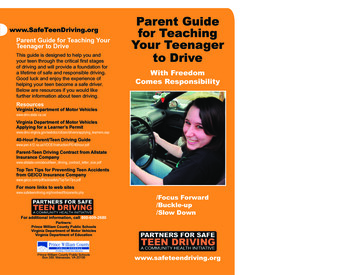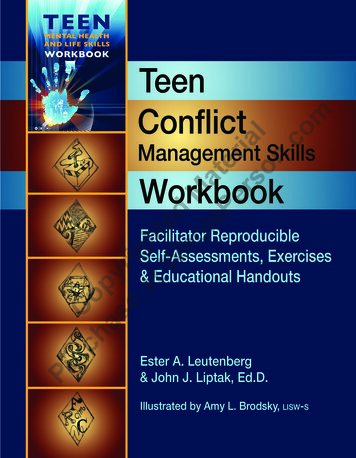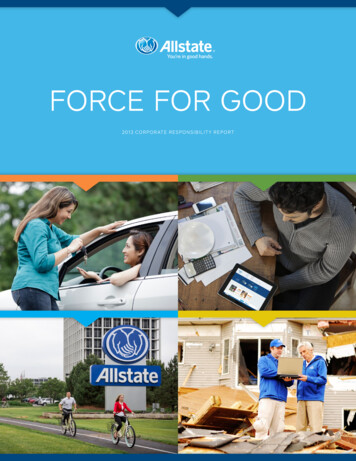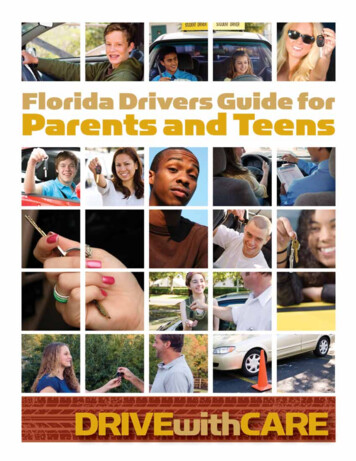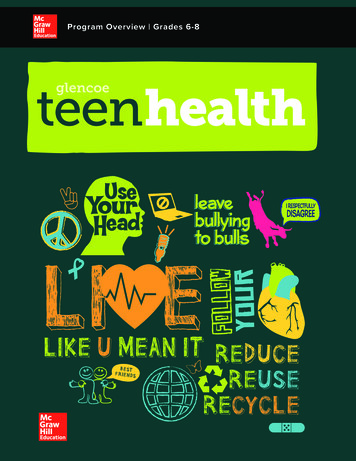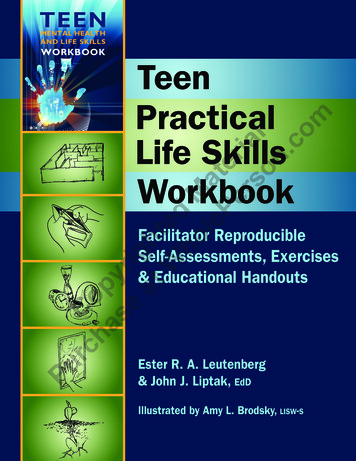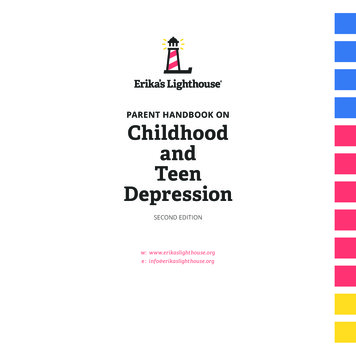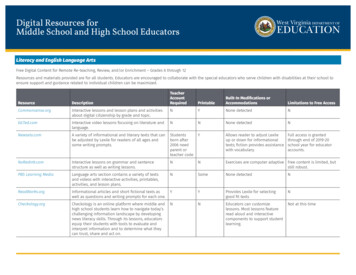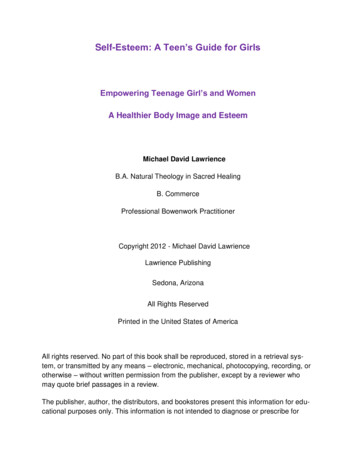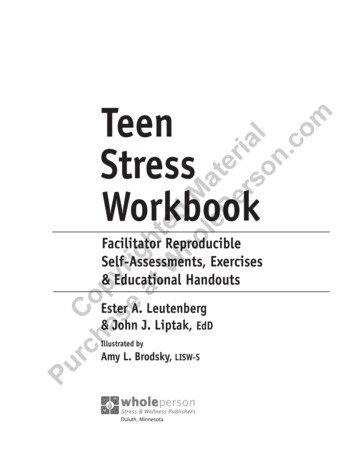
Transcription
rc Coha pse yriat ghW tedho Mle atPe errs ialon.comTeenStressWorkbookFacilitator ReproducibleSelf-Assessments, Exercises& Educational HandoutsEster A. Leutenberg& John J. Liptak, EdDPuIllustrated byAmy L. Brodsky, LISW-SDuluth, Minnesota
rc Coha pse yriat ghW tedho Mle atPe errs ialon.comWhole Person210 West Michigan StreetDuluth, MN leperson.comTeen Stress WorkbookFacilitator Reproducible Self-Assessments,Exercises & Educational HandoutsCopyright 2012 by Ester A. Leutenberg and John J. Liptak.All rights reserved. Except for short excerpts for review purposesand materials in the assessment, journaling activities, andeducational handouts sections, no part of this book may bereproduced or transmitted in any form by any means, electronicor mechanical without permission in writing from the publisher.Self-assessments, exercises, and educational handouts are meantto be photocopied.All efforts have been made to ensure accuracy of the informationcontained in this book as of the date published. The author(s)and the publisher expressly disclaim responsibility for anyadverse effects arising from the use or application of theinformation contained herein.Printed in the United States of America10 9 8 7 6 5 4 3 2 1PuEditorial Director: Carlene SippolaArt Director: Joy Morgan DeyLibrary of Congress Control Number: 2011938511ISBN: 978-1-57025-258-7
Using This Book(For the professional)Adolescence can be a period of significant change for most teens, leading them toexperience stress.rc Coha pse yriat ghW tedho Mle atPe errs ialon.comStress is the way our bodies and minds react to changes in life. Stress, an uncomfortablefeeling teens get, is triggered when they are overwhelmed, out of control, frustrated, orexcessively worried about something.Because of the multiple life changes teens must work through, many find themselves undermore stress than they have formerly experienced in their life.Stress can come from many different sources: Family members’ constant reminders such as “Don’t use drugs,” “Go out for thatteam,” “I don’t like your friends,” “Make new friends,” “Get good grades,” “You have acurfew,” and “Stay out of trouble.” Friends frequent reminders and suggestions such as “Be cool,” “Skip that class,” “Takeone drink,” “Try this,” “Don’t hang around that person,” “Let’s pick on that person,” and“Let’s cheat on the test.” Teen inner thoughts and worries such as “I need to lose weight,” “If I don’t do betterI will never get into college,” “My parents will be upset with me,” “I don’t fit in atschool,” and “I should get a job.” Adults’ remarks such as “You need to get that done,” “You were late,” and “Get it doneor you will get into trouble.”No one can avoid stress. Small amounts of stress can be okay, but chronic stresscan push people beyond the limits of what can be handled.Some facts about stress: Teens are trying to cope with many physical, social, and emotional changes duringadolescence. Teens are struggling to make their own decisions and develop their own identity. Teens are more resilient than most people expect. Teens need to feel competent and in control in order to cope with stress.Pu Teens often have trouble identifying or expressing their feelings about being stressed. Teens are struggling for independence from their family. Teens are torn between their need for more responsibility and their dependence onfamily members and adults. When teens are experiencing chronic stress, even the smallest amount of additionalstress can trigger strong negative emotional responses.(Continued on the next page)
Using This Book (For the professional, continued)rc Coha pse yriat ghW tedho Mle atPe errs ialon.comThe Teen Stress Workbook contains five separate sections to help teens learn more aboutthemselves and the skills they possess and learn to manage the stress that occurs in theirlives. Participants will learn new skills and the importance of preventing, managing andcoping with stress and its symptoms. How Do I know When I’m Stressed Scale helps teens to explore the behavioral,emotional, and physical signs and symptoms, and their intensity. My Stressors Scale helps teens examine the various sources of stress in their lives. Eustress vs. Distress Scale helps teens identify ways to build resiliency inpreventing and dealing with stress and its symptoms. Stressed for Success Scale helps teens identify the various ways that they put toomuch pressure on themselves. How I Deal with My Stress Scale helps teens identify their effectiveness in copingwith stress and the symptoms of stress.Use Codes for ConfidentialityConfidentiality is a term for any action that preserves the privacy of other people. Becauseteens completing the activities in this workbook might be asked to answer assessment itemsand to journal about and explore their relationships, you will need to discuss confidentialitybefore you begin using the materials in this workbook. Maintaining confidentiality isimportant because it shows respect for others and allows participants to explore theirfeelings without hurting anyone’s feelings or fearing gossip, harm or retribution.PuIn order to maintain confidentiality, explain to the participants that they need to assign aname code for each person or each group of people they write about as they completethe various activities in the workbook. For example, a friend named Joey who enjoys goingto hockey games might be titled JLHG (Joey Loves Hockey Games) for a particular exercise. Inorder to protect their friends’ identities, they should not use actual names or initials of peopleor groups, only name codes.(Continued on the next page)
Using This Book (For the professional, continued)The Teen Stress Workbook is designed to be used either independently or as part of anintegrated curriculum. You may administer one of the assessments and the journalingexercises to an individual or a group with whom you are working, or youmay administer a number of the assessments over one or more days.rc Coha pse yriat ghW tedho Mle atPe errs ialon.comThis book includes the following reproducible pages in the first five sections: Assessment Instruments – Self-assessment inventories with scoring directions andinterpretation materials. Group facilitators can choose one or more of the activities relevantto their participants. Activity Handouts – Practical questions and activities that prompt self-reflection andpromote self-understanding. These questions and activities foster introspection andpromote pro-social behaviors. Quotations – Quotations are used in each section to provide insight and promotereflection. Participants will be asked to select one or more of the quotations and journalabout what the quotations mean to them. Reflective Questions for Journaling – Self-exploration activities and journaling exercisesspecific to each assessment to enhance self-discovery, learning, and healing. Educational Handouts – Handouts designed to enhance instruction can be used byindividuals or in groups to promote a positive understanding of managing stress. Theycan be distributed, scanned and converted into masters for overheads or transparencies,projected or written on boards and /or discussed.Who Should Use This Program?This book has been designed as a practical tool to help professionals such as therapists,counselors, psychologists, teachers, group leaders, etc. Depending on the role of the professionalusing the Teen Stress Workbook and the specific person’s or group’s needs, these sections can beused individually or combined for a more comprehensive approach.Why Use Self-Assessments? Self-assessments are important in teaching various stress management skills because theyhelp participants to engage in several ways: Become aware of the primary motivators that guide their behavior Explore and let go of troublesome habits and behavioral patterns learned in childhood Examine the effects of unconscious childhood messagesPu Gain insight and recognize a “wake-up call” for behavioral change Focus thinking on behavioral goals for positive change Uncover personal resources that can help them to cope better with problems and difficulties Explore personal characteristics without judgment Identify personal strengths and weaknessesBecause the assessments are presented in a straightforward and easy-to-use format,individuals can self-administer, score and interpret each assessment at their own pace.
About the Assessments, Journaling Activitiesand Educational Handoutsrc Coha pse yriat ghW tedho Mle atPe errs ialon.comMaterials in the Assessments, Journaling Activities, and Educational Handouts sections in thisbook are reproducible and can be photocopied for participants’ use. Assessments containedin this book focus on self-reported data and thus are similar to ones used by psychologists,counselors, therapists, and career consultants. The accuracy and usefulness of theinformation provided is dependent on the truthful information that each participant provides.By being honest, participants help themselves to learn about unproductive and ineffectivepatterns in their lives, and to uncover information that might be keeping them from being ashappy or as successful as they might be.An assessment instrument can provide participants with valuable information aboutthemselves; however, these assessments cannot measure or identify everything. Theassessments’ purpose is not to pigeonhole certain characteristics, but rather to allowparticipants to consider all of their characteristics. This book contains self-assessments, nottests. Tests measure knowledge or whether something is right or wrong. For the assessmentsin this book, there are no right or wrong answers. These assessments ask for personalopinions or attitudes about a topic of importance in the participant’s life.When administering the assessments in this workbook, remember that the items aregenerically written so that they will be applicable to a wide variety of people but may notaccount for every possible variable for every person. No assessments are specifically tailoredto one person. Assessments are structured to help a variety of participants to identifynegative themes in their lives and find ways to break the hold of these patterns andtheir effects.Advise teen participants taking the assessments that they should not spend too much timetrying to analyze the content of the questions; they should think about the questions ingeneral and then spontaneously report how they feel about each one. Whatever the resultsof the assessment, encourage participants to talk about their findings and their feelingspertaining to what have they discovered about themselves. Talking about issues such as teenstress and coping can be therapeutic and beneficial.PuThe Teen Stress Workbook sections serve as an avenue for individual self-reflection, as wellas group experiences revolving around identified topics of importance. Each assessmentincludes directions for easy administration, scoring and interpretation. In addition, eachsection includes exploratory activities, reflective journaling activities, insightful quotationsand educational handouts to help participants to learn more about the stress they areexperiencing and how to effectively manage the stress they will inevitably have in the future.(Continued on the next page)
About the Assessments, Journaling Activitiesand Educational Handouts (Continued)rc Coha pse yriat ghW tedho Mle atPe errs ialon.comThe art of self-reflection goes back many centuries and is rooted in many of the world’sgreatest spiritual and philosophical traditions. Socrates, the ancient Greek philosopher,was known to walk the streets engaging the people he met in philosophical reflection anddialogue. He felt that this type of activity was so important in life that he proclaimed, “Theunexamined life is not worth living!” The unexamined life is one in which the same routineis continually repeated without ever thinking about its meaning to one’s life and how thislife really could be lived. However, a structured reflection and examination of beliefs,assumptions, characteristics and patterns can provide a better understanding which can leadto a more satisfying life and career. A greater level of self-understanding about importantlife skills is often necessary to make positive, self-directed changes in repetitive negativepatterns throughout life. The assessments and exercises in this book can help promote thisself-understanding. Through involvement with the in-depth activities, each participant claimsownership in the development of positive patterns.Journaling is an extremely powerful tool for enhancing self-discovery, learning, transcendingtraditional problems, breaking ineffective life and career habits, and helping people to healfrom psychological traumas of the past. From a physical point of view, writing reduces stressand lowers muscle tension, blood pressure and heart rate levels. Psychologically, writingreduces feelings of sadness, depression and general anxiety, and it leads to a greater level oflife satisfaction and optimism. Behaviorally, writing leads to enhanced social skills, emotionalintelligence and creativity.By combining reflective assessment and journaling, your participants will engage in apowerful method for managing the inevitable stress they will have in the future.PuThanks to the following professionals whose input in this book has been invaluable!Amy Brodsky, LISW-SJay LeutenbergCarol Butler, MS Ed, RN, CHannah LavoieKathy Khalsa, MAJS, OTR / LKathy Liptak, Ed.D.Eileen Regen, M.Ed., CJE
Introduction for the Participantrc Coha pse yriat ghW tedho Mle atPe errs ialon.comLike adults, you experience stress every day. You will benefit from learning effective stressmanagement skills. A little bit of stress is okay, and can even be helpful. However, when youbecome overloaded with stress or the stress lasts for long periods of time, the stress needsto be managed. When you are unable to adequately manage your stress, you may feel anxietyor depression, experience physical problems, withdraw from family and friends, displayaggression or bullying behavior and even become involved with drug and / or alcohol abuse.You will experience stress when you perceive a situation too challenging, too difficult, toopainful, or beyond your control. Some of your stress sources might include the following: Changes in your physical appearance Death of a pet Negative feelings about yourself Change in family living situation Problems with peers at school Move to a new neighborhood or city Unsafe living conditions at home Change of schools Separation or divorce of parents Peer pressure Death of a loved one BullyingThis workbook will help you develop and polish the skills you need to build basic resiliencyhabits, prime your coping skills when you encounter stress, and manage effective stressmanagement skills. You may encounter many of the above types of stress in your lifetime.When you encounter negative changes in your environment, changes occur in your mindand body to prepare you for that change. You can, however, minimize and reverse this stressresponse by using the stress management techniques contained in this workbook.You will be encouraged throughout this workbook to complete assessments, journalingactivities and exercises. Because active involvement is as important as talking about theories,it is to your best advantage to take the time to complete all of the skill-building exercises.The Teen Stress Workbook is designed to help you learn more about yourself, identify theprimary reasons you are feeling stress, and find better ways to use your newfound stressmanagement skills to feel more confident and less helpless, and to cope and make betterchoices when responding to stress.IMPORTANTPuYou will be asked to respond to assessment items and to journal aboutand explore your relationships with your friends. Everyone has the right toconfidentiality, and you need to honor the right to privacy of others. Think aboutit this way – you would not want someone writing things about you that otherpeople could read about. Your friends feel this way also.In order to maintain the confidentiality of your friends, assign people code namesbased on things you know about them. For example, a friend named Sherry wholoves to wear purple might be coded as SWP (Sherry Wears Purple). Do not useactual names of people or groups when you are listing your friends.
Teen Stress Workbooktable of ContentsSection I: How Do I Know When I’m Stressed? Scalerc Coha pse yriat ghW tedho Mle atPe errs ialon.comDirections . . . . . . . . . . . . . . . . . . . . . . . . . . . . . . . . . . . . . . . . 15How Do I Know When I’m Stressed? Scale . . . . . . . . . . . . . 16–17Scoring Directions . . . . . . . . . . . . . . . . . . . . . . . . . . . . . . . . . . . 18Profile Interpretation . . . . . . . . . . . . . . . . . . . . . . . . . . . . . . . . 18ExercisesBehavioral Coping Skills – Mental Imagery . . . . . . . . . . . . . . . .Behavioral Coping Skills – Total-Body Relaxation . . . . . . . . . . .Behavioral Coping Skills – Breathing . . . . . . . . . . . . . . . . . . . .Physical Coping Skills – Eating Better . . . . . . . . . . . . . . . . . . . .Physical Coping Skills – Sleep Better . . . . . . . . . . . . . . . . . . . .Emotional Coping Skills – Creativity . . . . . . . . . . . . . . . . . . . .Emotional Coping Skills – Talk with Othersand Identifying Passions . . . . . . . . . . . . . . . . . . . . . . . . .Emotional Coping Skills – Laughing or Crying . . . . . . . . . . . . .Emotional Coping Skills – Help Others . . . . . . . . . . . . . . . . . . .192021222324252627Journaling ActivitiesStress Management Skills . . . . . . . . . . . . . . . . . . . . . . . . . . . . . 28Stress Management Quotations . . . . . . . . . . . . . . . . . . . . . . . . 29Educational HandoutsReactions to Too Much Stress . . . . . . . . . . . . . . . . . . . . . . . . . 30Additional Ways of Coping with Stress . . . . . . . . . . . . . . . . . . . 31Section II: My Stressors ScaleDirections . . . . . . . . . . . . . . . . . . . . . . . . . . . . . . . . . . . . . . . . 35My Stressors Scale . . . . . . . . . . . . . . . . . . . . . . . . . . . . . . 36–37Scoring Directions . . . . . . . . . . . . . . . . . . . . . . . . . . . . . . . . . . . 38Profile Interpretation . . . . . . . . . . . . . . . . . . . . . . . . . . . . . . . . 38PuExercisesSchool . . . . . . . . . . . . . . . . . . . . . . . . . . . . . . . . . . . . . . . . . . . 39School Pressure . . . . . . . . . . . . . . . . . . . . . . . . . . . . . . . . . . . . 40Family . . . . . . . . . . . . . . . . . . . . . . . . . . . . . . . . . . . . . . . . . . . 41Family Pressure . . . . . . . . . . . . . . . . . . . . . . . . . . . . . . . . . . . . 42Personal . . . . . . . . . . . . . . . . . . . . . . . . . . . . . . . . . . . . . . . . . . 43Personal Pressure . . . . . . . . . . . . . . . . . . . . . . . . . . . . . . . . . . . 44Social . . . . . . . . . . . . . . . . . . . . . . . . . . . . . . . . . . . . . . . . . . . . 45Social Pressure . . . . . . . . . . . . . . . . . . . . . . . . . . . . . . . . . . . . . 46The Problem-Solving Process . . . . . . . . . . . . . . . . . . . . . . . 47–49Journaling ActivitiesSources of Stress Quotes . . . . . . . . . . . . . . . . . . . . . . . . . . . . . 50My Greatest Sources of Stress . . . . . . . . . . . . . . . . . . . . . . . . . 51
table of ContentsEducational HandoutsTeenage Stress Factors . . . . . . . . . . . . . . . . . . . . . . . . . . . . . . . 52Types of Stress . . . . . . . . . . . . . . . . . . . . . . . . . . . . . . . . . . . . . 53rc Coha pse yriat ghW tedho Mle atPe errs ialon.comSection III: Eustress vs. DistressDirections . . . . . . . . . . . . . . . . . . . . . . . . . . . . . . . . . . . . . . . . 57Eustress vs. Distress Scale . . . . . . . . . . . . . . . . . . . . . . . . . 58–59Scoring Directions . . . . . . . . . . . . . . . . . . . . . . . . . . . . . . . . . . . 60Profile Interpretation . . . . . . . . . . . . . . . . . . . . . . . . . . . . . . . . 60ExercisesChallenges . . . . . . . . . . . . . . . . . . . . . . . . . . . . . . . . . . . . . . . . 61My Upcoming Challenge . . . . . . . . . . . . . . . . . . . . . . . . . . . . . 62Optimism . . . . . . . . . . . . . . . . . . . . . . . . . . . . . . . . . . . . . . . . . 63Optimistic Views of my Challenge . . . . . . . . . . . . . . . . . . . . . . 64Control in the Situation . . . . . . . . . . . . . . . . . . . . . . . . . . . . . . . 65Focus . . . . . . . . . . . . . . . . . . . . . . . . . . . . . . . . . . . . . . . . . . . . 66Setting Goals . . . . . . . . . . . . . . . . . . . . . . . . . . . . . . . . . . . . . . . 67Focus on Setting Goals . . . . . . . . . . . . . . . . . . . . . . . . . . . . 68–69Putting it All Together . . . . . . . . . . . . . . . . . . . . . . . . . . . . . . . 70Journaling ActivitiesEustress . . . . . . . . . . . . . . . . . . . . . . . . . . . . . . . . . . . . . . . . . . 71Good Stress Quotations . . . . . . . . . . . . . . . . . . . . . . . . . . . . . . 72Educational HandoutsCharacteristics of Distress . . . . . . . . . . . . . . . . . . . . . . . . . . . . 73Characteristics of Eustress . . . . . . . . . . . . . . . . . . . . . . . . . . . . 74Examples of Eustress (Good Stress) . . . . . . . . . . . . . . . . . . . . . 75Section IV: Stressed for Success ScalePuScale Directions . . . . . . . . . . . . . . . . . . . . . . . . . . . . . . . . . . . . 79Stressed for Success Scale . . . . . . . . . . . . . . . . . . . . . . . . . 80–81Scoring Directions . . . . . . . . . . . . . . . . . . . . . . . . . . . . . . . . . . . 82Profile Interpretation . . . . . . . . . . . . . . . . . . . . . . . . . . . . . . . . 82ExercisesAcademics . . . . . . . . . . . . . . . . . . . . . . . . . . . . . . . . . . . . . . . .Things I Do Well in School . . . . . . . . . . . . . . . . . . . . . . . . . . . .Things I Do Not Do Well in School . . . . . . . . . . . . . . . . . . . . . .Over-Extending . . . . . . . . . . . . . . . . . . . . . . . . . . . . . . . . . . . .My Activities . . . . . . . . . . . . . . . . . . . . . . . . . . . . . . . . . . . . . . .High Expectations . . . . . . . . . . . . . . . . . . . . . . . . . . . . . . . . . . .Expectations on Me . . . . . . . . . . . . . . . . . . . . . . . . . . . . . . . . .83848586878889
table of ContentsFuture . . . . . . . . . . . . . . . . . . . . . . . . . . . . . . . . . . . . . . . . . . .I’m Worried . . . . . . . . . . . . . . . . . . . . . . . . . . . . . . . . . . . . . . . .My Work/Career Future . . . . . . . . . . . . . . . . . . . . . . . . . . . . . . .Future Preparation . . . . . . . . . . . . . . . . . . . . . . . . . . . . . . . . . .90919293rc Coha pse yriat ghW tedho Mle atPe errs ialon.comJournaling ActivitiesPressure to Succeed Quotes . . . . . . . . . . . . . . . . . . . . . . . . . . . 94My Thoughts . . . . . . . . . . . . . . . . . . . . . . . . . . . . . . . . . . . . . . . 95Educational HandoutsIneffective Responses to Pressure . . . . . . . . . . . . . . . . . . . . . . . 96Effective Responses to Pressure . . . . . . . . . . . . . . . . . . . . . . . . 96Ways to Overcome Pressure to Succeed . . . . . . . . . . . . . . . . . . 97Section V: How I Deal with My Stress ScaleDirections . . . . . . . . . . . . . . . . . . . . . . . . . . . . . . . . . . . . . . . 101How I Deal with My Stress Scale . . . . . . . . . . . . . . . . . . 102–103Scoring Directions . . . . . . . . . . . . . . . . . . . . . . . . . . . . . . . . . . 104Profile Interpretation . . . . . . . . . . . . . . . . . . . . . . . . . . . . . . . 104ExercisesMy Helping Skills . . . . . . . . . . . . . . . . . . . . . . . . . . . . . . . . . .Unrealistic Expectations . . . . . . . . . . . . . . . . . . . . . . . . . . . . .Set Realistic Goals . . . . . . . . . . . . . . . . . . . . . . . . . . . . . . . . . .What goes Through My Head? . . . . . . . . . . . . . . . . . . . . . . . .Adding Physical Activities . . . . . . . . . . . . . . . . . . . . . . . . . . .Worry Journal . . . . . . . . . . . . . . . . . . . . . . . . . . . . . . . . . . . . .Plan Your Time . . . . . . . . . . . . . . . . . . . . . . . . . . . . . . . . . . . .Who Can I Talk To? . . . . . . . . . . . . . . . . . . . . . . . . . . . . . . . . .Changes in my Wellness Habits . . . . . . . . . . . . . . . . . . . . . . .My Strengths . . . . . . . . . . . . . . . . . . . . . . . . . . . . . . . . . . . . . .Learning to Say “NO” . . . . . . . . . . . . . . . . . . . . . . . . . . . . . . .105106107108109110111112113114115Journaling ActivitiesPuSources of Stress Quotes . . . . . . . . . . . . . . . . . . . . . . . . . . . . 116My Greatest Sources of Stress . . . . . . . . . . . . . . . . . . . . . . . . 117Educational HandoutsA Healthy Stress Mind-Set . . . . . . . . . . . . . . . . . . . . . . . . . . . 118Unhealthy Ways of Coping with Stress . . . . . . . . . . . . . . . . . . 118Additional Stress Management Technique . . . . . . . . . . . . . . . 119
rc Coha pse yriat ghW tedho Mle atPe errs ialon.comPu
Section I:rc Coha pse yriat ghW tedho Mle atPe errs ialon.comHow Do I KnowWhen I'm Stressed?ScalePuNameDate 2012 Whole Person Associates, 210 West Michigan St., Duluth MN 55802-1908 800-247-678915
rc Coha pse yriat ghW tedho Mle atPe errs ialon.comPu16 2012 Whole Person Associates, 210 West Michigan St., Duluth MN 55802-1908 800-247-6789
Section I: how do i know when i'm stressed? scalerc Coha pse yriat ghW tedho Mle atPe errs ialon.comHow Do I Know When I’m Stressed?Scale DirectionsWe all experience stress, but we all react to each stress differently. Signs and symptoms differ fromperson to person. Some react to stress behaviorally, while others react emotionally or physically.This assessment will help you learn more about how you experience stress so that you will knowwhen you are experiencing too much stress in your life.This assessment contains descriptors of the symptoms of stress that are divided into threesections. Think about the times when you were or are feeling stressed. Place a check in the boxesthat describe your reactions to the stress. In the following example, the 4 shows that the personcompleting the assessment forgets things and feels bored when experiencing stress.When I am stressed, I find myself (4)q Fighting a lotq Forgetting things4q Feelingbored4q Writingsad e-mail/textsPuThis is not a test and there are no right or wrong answers. Do not spend too much timethinking about your answers. Your initial response will be the most true for you.Be sure to respond to every statement.(Turn to the next page and begin) 2012 Whole Person Associates, 210 West Michigan St., Duluth MN 55802-1908 800-247-678917
Section I: how do i know when i'm stressed? scaleHow Do I Know When I’m Stressed?ScaleWhen I am stressed, I find myself ( 4 )q Feeling anxiousq Forgetting thingsq Feeling upsetq Feeling boredq Feeling depressedq Writing sad e-mails/textsq Feeling sadq Isolating myselfq Feeling hopelessq Drinking alcoholic beveragesq Feeling bad about myselfq Taking illegal/addictive drugsq Losing my self-confidenceq Getting poor gradesq Feeling out of controlq Focusing poorlyq Getting distracted easilyq Losing my temper easilyq Feeling tired constantlyq Avoiding my studiesq Feeling like I don’t careq Getting overwhelmed easilyq Worryingq Drawing sad picturesq Being pessimistic a lotq Bullying othersq Feeling abandonedq Failing to copeq Feeling fearfulq Cursingq Feeling grouchyq Being bulliedq Having aches and painsq Wanting to run away from thingsq Feeling picked onq Letting little things bother meq Crying oftenq Verbally attacking othersq Feeling aloneq Otherq Otherrc Coha pse yriat ghW tedho Mle atPe errs ialon.comq Fighting a lotq OtherB TOTAL E TOTAL Puq Other(Continued on the next page)18 2012 Whole Person Associates, 210 West Michigan St., Duluth MN 55802-1908 800-247-6789
Section I: how do i know when i'm stressed? scaleHow Do I Know When I’m Stressed?Scale (continued)When I am stressed, I find myself ( 4 )rc Coha pse yriat ghW tedho Mle atPe errs ialon.comq Skipping mealsq Sleeping too muchq Experiencing a fast heartbeatq Perspiring a lotq Having clammy handsq Acting without thinkingq Having nightmaresq Biting my fingernailsq Pulling my hair outq Sleeping restlesslyq Getting an upset stomachq Losing weight rapidlyq Eating constantlyq Getting a rashq Suffering from headachesq Feeling dizzy or light-headedq Feeling bad all overq Feeling tired all the timeq Crying a lotq Feeling my heart racing or thumpingq OtherPuq OtherP TOTAL (Go to the Scoring Directions on the next page) 2012 Whole Person Associates, 210 West Michigan St., Duluth MN 55802-1908 800-247-678919
Section I: how do i know when i'm stressed? scaleHow Do I Know When I’m Stressed? ScaleScoring Directionsrc Coha pse yriat ghW tedho Mle atPe errs ialon.comEveryone experiences signs and symptoms of stress. It is important to identify yoursymptoms when you are stressed, to become aware of them and to notice how you areaffected. This assessment will help you explore the various ways you experience symptomsof stress. For each of the sections, count the number of boxes in which you placed a 4.You will receive a score from 0 to 22. Put that total on the line marked TOTAL at the end ofeach section.Transfer your totals to the spaces below:B (BEHAVIORAL) TOTAL E (EMOTIONAL) TOTAL P (PHYSICAL)TOTAL Profile InterpretationResult15 to 22high8 to 14moderate0 to 7lowIndicationsIf you score high on any of the scales, you tend toexperience a great deal of stress in that mode.If you score moderate on any of the scales, you tend toexperience some stress in that mode.If you score low on any
The Teen Stress Workbook contains five separate sections to help teens learn more about themselves and the skills they possess and learn to manage the stress that occurs in their lives. Participants will learn new skills and the importance of preventing, managing
